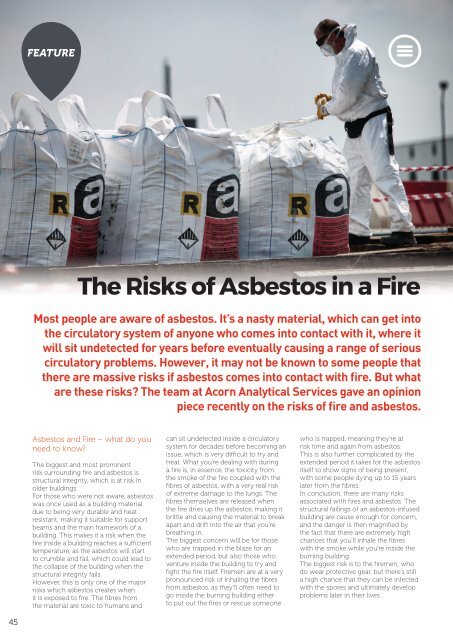UK Construction Excellence September
- No tags were found...
Create successful ePaper yourself
Turn your PDF publications into a flip-book with our unique Google optimized e-Paper software.
The Risks of Asbestos in a Fire<br />
Most people are aware of asbestos. It’s a nasty material, which can get into<br />
the circulatory system of anyone who comes into contact with it, where it<br />
will sit undetected for years before eventually causing a range of serious<br />
circulatory problems. However, it may not be known to some people that<br />
there are massive risks if asbestos comes into contact with fire. But what<br />
are these risks? The team at Acorn Analytical Services gave an opinion<br />
piece recently on the risks of fire and asbestos.<br />
Asbestos and Fire – what do you<br />
need to know?<br />
The biggest and most prominent<br />
risk surrounding fire and asbestos is<br />
structural integrity, which is at risk in<br />
older buildings.<br />
For those who were not aware, asbestos<br />
was once used as a building material<br />
due to being very durable and heat<br />
resistant, making it suitable for support<br />
beams and the main framework of a<br />
building. This makes it a risk when the<br />
fire inside a building reaches a sufficient<br />
temperature, as the asbestos will start<br />
to crumble and fail, which could lead to<br />
the collapse of the building when the<br />
structural integrity fails.<br />
However, this is only one of the major<br />
risks which asbestos creates when<br />
it is exposed to fire. The fibres from<br />
the material are toxic to humans and<br />
can sit undetected inside a circulatory<br />
system for decades before becoming an<br />
issue, which is very difficult to try and<br />
treat. What you’re dealing with during<br />
a fire is, in essence, the toxicity from<br />
the smoke of the fire coupled with the<br />
fibres of asbestos, with a very real risk<br />
of extreme damage to the lungs. The<br />
fibres themselves are released when<br />
the fire dries up the asbestos, making it<br />
brittle and causing the material to break<br />
apart and drift into the air that you’re<br />
breathing in.<br />
The biggest concern will be for those<br />
who are trapped in the blaze for an<br />
extended period, but also those who<br />
venture inside the building to try and<br />
fight the fire itself. Firemen are at a very<br />
pronounced risk of inhaling the fibres<br />
from asbestos, as they’ll often need to<br />
go inside the burning building either<br />
to put out the fires or rescue someone<br />
who is trapped, meaning they’re at<br />
risk time and again from asbestos.<br />
This is also further complicated by the<br />
extended period it takes for the asbestos<br />
itself to show signs of being present,<br />
with some people dying up to 15 years<br />
later from the fibres.<br />
In conclusion, there are many risks<br />
associated with fires and asbestos. The<br />
structural failings of an asbestos-infused<br />
building are cause enough for concern,<br />
and the danger is then magnified by<br />
the fact that there are extremely high<br />
chances that you’ll inhale the fibres<br />
with the smoke while you’re inside the<br />
burning building.<br />
The biggest risk is to the firemen, who<br />
do wear protective gear, but there’s still<br />
a high chance that they can be infected<br />
with the spores and ultimately develop<br />
problems later in their lives.<br />
45






